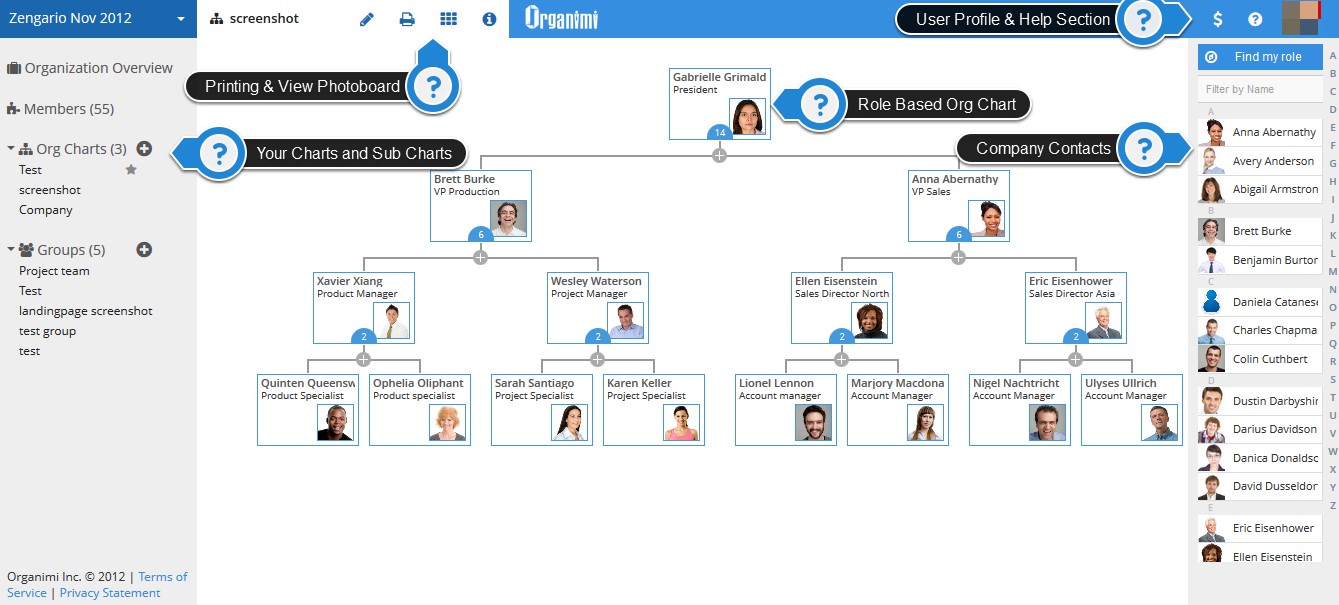Marc Barros is a smart guy. He has done a bunch of cool stuff. You might recognize his name as a co-founder of wearable camera start-up Contour, where he stepped down earlier this year as CEO.
These days, among lots of other things, he writes for Inc Magazine and recently wrote a piece in Inc Magazine titled ‘Why Your Startup Org Chart is Pointless‘.
He makes some good points, but when we saw HR professionals and others sharing the link across the Twittersphere like wildfire, we wondered what was up.
Marc focuses on startups. Assuming the typical startup in its early months has less than 10 to 20 people, maybe it is kind of pointless to have an org chart in the first place. Perhaps this is not “highest best use” of your team’s talents – especially when the odds are most of them are practically sitting on top of each other anyway, and likely know each other (warts and all) better than they might even know their own neighbours.
Who gets off moving boxes around in Excel or Powerpoint.
When you’re this small, your structure is pretty flexible; everyone is “chief cook and bottle washer” and perhaps there is no need to formalize structure, relationships, and reporting.
But when does this end? Where does the transition start to happen?
We all know that one of the biggest reasons the successful start-ups collapse is their inability to scale…to grow up. They’re like the big tomato plant on your condo balcony, thick with promise until they fall over due to the weight of their success.
If you are a small startup with big plans, whether or not you are growing like a weed yet, an organizational design and an org chart that focuses on where you are going, and where you are growing, is great at communicating intention to the team, and getting people focused forward, and not on where you have been? Org charts make good fertilizer.
And what if you’re not a small startup after all? Once you get past 20-25 employees things break down pretty fast. Not everyone is a social butterfly, and most people are actually a lot less social than they think they are. Getting to know more about people you work with it really useful, if you can do it on your own time and your own terms. So Organimi’s cloud based org charts are ideal for this kind of information gathering.
We think the reason Marc’s comments provoked some action, is that he is talking about (and maybe even thinking about) org charts in the dusty old fashioned format. Too many organizations keep their org charts closely guarded, paper based, and gathering dust. This is in sharp contrast with their own fast paced day to day operations where staff changes are happening with the same pace of everything else in their business – at Internet speed.
We heartily agree. Org charts should not just be a bunch of boxes on paper; they need to be part of the foundation of your organization – the roadmap your team can follow to get ahead, and even keep from getting lost. They are immensely useful in helping align your organizational strategy and the people who need to execute it. We have a few guest posts from Linda Barlow on point if you want to check them out.
This is why here at Organimi we are building a different environment – online – for creating, managing and sharing your organizational structure.

We don’t see org charts as a set of boxes in someone’s software program with stale information in them.
We see your org chart as a central hub for your organization – a meeting and greeting place for people to get to know each other, and share useful information about themselves. One of our customers has tied their Organimi instance to their HR database – a configuration option we support and automate – making it easy for their HR managers and line of business execs so quickly and conveniently get access to the information they need to see, right away…and wouldn’t you believe it? They’ve told us it is much easier then viewing the data clumps on Excel.
They should be visible and accessible by everyone. As you grow as a company, newer faces appear and its always good to know someones name and what they do before you go and say hello followed by an awkward silence. A story related to that can be found here on our blog. As the company grows and reporting relationships get complicated, they need to be mapped out and also account for the fact that they change. Especially in a dotted line reporting scenario, more about how Organimi handles dotted line reporting can be found here.
Most people don’t create start-ups thinking they’ll employ 5 people. 500 or 5000 more like it. That’s the way to think, and with Organimi you can start mapping out how that is going to happen. It’s free for up to 500 members so you can be well on your way.
Meanwhile, back at the Organimi, we’re also eating our own dog food, as the saying goes. We’ve got a small team, and likely don’t need a fancy org chart, but we’re adding features as we go and grow, making it easier for us to connect, collaborate and communicate as a virtual team in our virtual workspace one of them being an eStandup add-on.
So with all due respect Mr Barros, I beg to differ. I don’t think the org chart is pointless or dead yet. We just need to re-frame our perspective on the good old Org Chart, bring it into the 21st century as a forward looking planning and collaboration tool accessible to everyone, and re-invent how we use it in our day to day worklife.
When used properly, a great org chart can be an awesome tool. That’s what we do here at Organimi. Make simply awesome org charts possible…for all the organizations you belong to, at work and at play.

